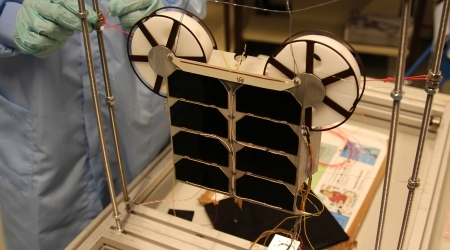One step closer to solar wind-powered spacecraft
A little over a year ago, a research team started to develop a vital part of a Finnish invention – an electric solar wind sail for interplanetary journeys. Now, a prototype has been successfully manufactured and tested.
“We are happy and proud to now have demonstrated that the unit not only can be designed, although it was certainly challenging, but also that it can be manufactured and that it satisfies its demanding specifications so that revolutionary electric sail spacecraft can be realised”, says Greger Thornell, who has worked on the project with his colleagues Johan Sundqvist and Sven Wagner at Ångström Space Technology Centre, ÅSTC, Uppsala University.
The electric solar wind sail is a groundbreaking new concept for efficient propellantless space journeys in interplanetary space, based on tapping momentum from the solar wind by up to 20 km long, thin, electrically charged radial wires stretched by centrifugal force. Full-scale electric sails could produce up to one Newton of continuous thrust and weigh 100–200 kg, and thus enable fast and economical access to the solar system.
The technology is being developed by the EU FP7 project ESAIL, the main goal of which is to develop and demonstrate laboratory prototypes of the key components of the sail.
With the successful manufacturing and rigorous space environment testing of a prototype unit to be used at the end of each of the sail’s spokes to hoist the sail and monitor the rig, an important step has now been taken. Basically, the unit is an autonomous device with many of the features of a large-scale satellite, including communication capabilities, power supply, propulsion system, onboard computer, and thermal control, but it weighs only about half a kilogram and it must work in a wide solar distance range from Earth to the outer asteroid belt.
Other teams involved in the subproject are: Nanospace AB, Uppsala; Alta S.p.A, Pisa, Italy; DLR-Bremen, Germany, and Tartu University, Estonia. The ESAIL project is led by the Finnish Meteorological Institute where the electric sail was invented.
Anneli Waara

